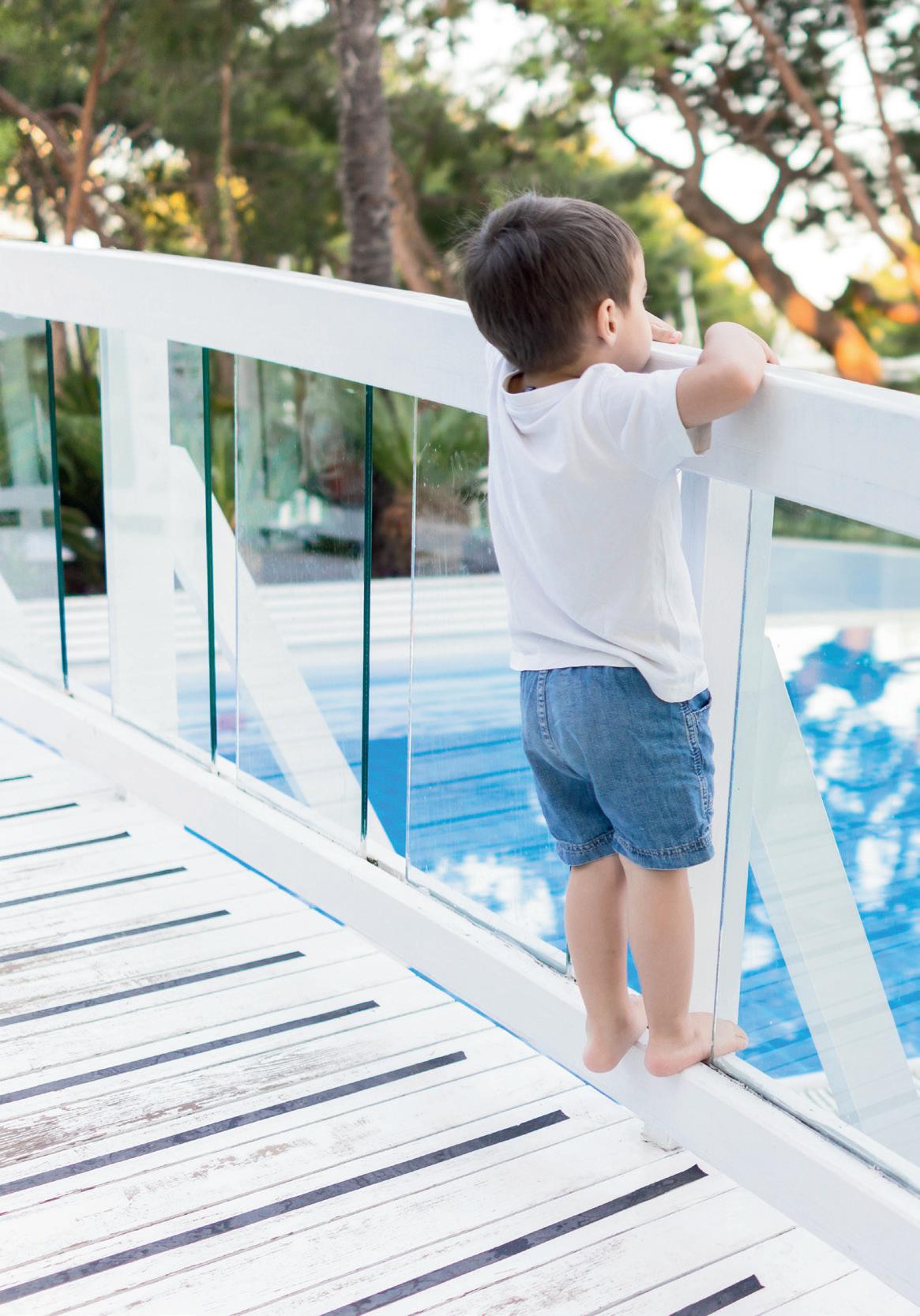
4 minute read
Tips for toddlers
Ten children between the ages of 3 and 5 years drown every year in Australia. Almost 50% of all drowning deaths occur in home swimming pools. Boys in this age group are twice as likely to drown than girls.
Restricting access to water, particularly in homes with swimming pools or easy access to water is vital. Correctly install and regularly maintain pool fencing and create a safe play area near the home. These years are a good time to enrol in learn-to-swim classes.
Actions to prevent your 3- to 5-year-old from drowning include: • Always actively supervise children around water. • Supervising adults should always be within arm’s reach of the child in and around water. • Ensure your pool fence is correctly installed, regularly maintained and the gate is never left open. • Create a safe play area to restrict a child’s access to water around the home. • Enrol your child in water familiarisation lessons and learn-to-swim classes. • Establish simple rules such as no going near water without an adult. • Learn CPR. Enrol in a course or update your skills.
To learn more, visit the Royal Life Saving Australia website (www.royallifesaving.com.au/) and click on the Keep Watch program button. Pool&Spa is produced for SPASA Australia
TIPS FOR
TODDLERS
Kids aged three to five need constant supervision around the pool. Royal Life Saving Australia offers the following tips to ensure everyone’s safety.
by Westwick-Farrow Media. Westwick-Farrow Media A.B.N. 22 152 305 336 www.wfmedia.com.au
Head Office:
Unit 7, 6–8 Byfield Street, (Locked Bag 2226) North Ryde BC NSW 1670, AUSTRALIA Ph: +61 2 9168 2500
Editor:
Dannielle Furness dfurness@wfmedia.com.au
Publishing Director:
Geoff Hird
Art Director/Production Manager:
Julie Wright
Art/Production:
Colleen Sam, Veronica King
Distribution:
Sue Lavery circulation@wfmedia.com.au
Advertising Sales:
David Stennett Ph: 0404 725 554 david@spasa.com.au
All material published in this magazine is published in good faith and every care is taken to accurately relay information provided to us. Readers are advised by the publishers to ensure that all necessary safety devices and precautions are installed and safe working procedures adopted before the use of any equipment found or purchased through the information we provide. Further, all performance criteria was provided by the representative company concerned and any dispute should be referred to them. Information indicating that products are made in Australia or New Zealand is supplied by the source company. Westwick-Farrow Pty Ltd does not quantify the amount of local content or the accuracy of the statement made by the source.
HOME OWNERS GUIDE Swimming & Spa Pool Equipotential Bonding

WATER AND ELECTRICITY DON'T MIX. MANDATORY ELECTRICAL WORK IS REQUIRED WHEN INSTALLING A SWIMMING OR SPA POOL DON'T PUT THE SAFETY OF YOUR FAMILY AT RISK!
THE LAW: BONDING IS LICENSED ELECTRICAL WORK

Electrical equipment and conductive metalwork in the general pool area is required to be equipotentially bonded (earthing).
This work is legally required to be performed by a licensed Electrician. Plan ahead. Discuss the electrical work with your pool builder:
• Engage with your electrical contractor early in the design/planning process • Install bonding conductors prior to build of pool & landscape construction • If possible, eliminate any conductive metal near the pool edge
WHAT NEEDS TO BE EQUIPOTENTIALLY BONDED
Equipotential bonding to the electrical earthing system is required for:*
• Installations where the pool structure is conductive (sheet metal structure - above ground pool) or contains metal within its structure (reinforcing steel of the pool shell or immediate surrounding deck) • Any conductive metal greater than 100mm in any dimension within 1.25m of the pool edge • Conductive ladders and diving boards associated with the pool • Conductive fencing that is within 1.25m of the pool edge
These shall be connected by an equipotential bonding conductor to the electrical earthing system of the property.
EQUIPMENT SELECTION / INSTALLATION METHOD
An equipotential bonding conductor and connection method shall be:*
• Appropriately designed and constructed (specifically for swimming and spa pool applications) • The earthing cable connecting the metal parts to the earthing system requires corrosion and mechanical resistant protection • Electrically tested to ensure the earth bonding cable and the associated conductive metal fixtures and fittings, reinforcing steel and conductive parts of electrical equipment are of the required low resistance
*as per AS/NZS3000:2018 (The Wiring Rules)
Please note that this is general guidance of the intent of the Wiring Rules. State regulators may have variances to this advice. You are strongly advised to engage with a Licensed Electrical Contractor (Master Electrician) to seek the best possible outcome.







